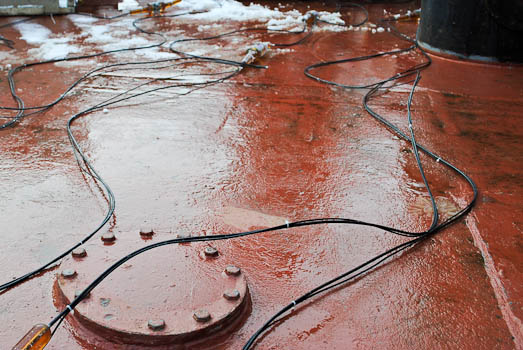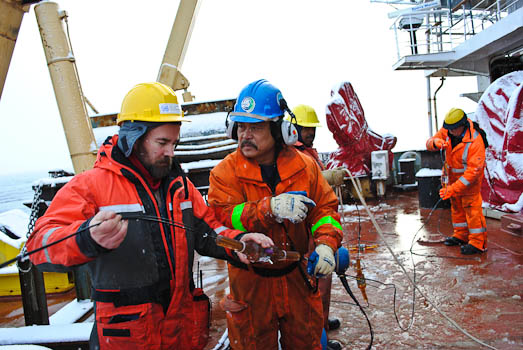Alex KainSeptember 28, 2009Yesterday, atop a deck dusted in snow, Mike Dempsey of the Canadian Institute of Ocean Sciences performed a favor for one of his colleagues, Mike Steele from the University of Washington, by deploying Steele's Autonomous Drifting Ocean Station (ADOS). The ADOS monitors ocean temperatures at depths of up to fifty meters. The buoy functions like many of the other monitors on board. A line descends from a top float. Eleven thermometer and barometer pairs, attached at equal intervals down the line, provide daily readings of the ocean's pressure and temperature. They send data up the line to the float, which is outfitted with an antenna that then transmits the data to the University of Washington via a satellite.
The ADOS is untethered. It drifts with the surface currents of the Beaufort Sea. While transmitting ocean profiles, it also provides information about the mass movement of water around the Arctic Ocean. Developing a model of the water's movement throughout the Beaufort Sea will help scientists understand future changes to Arctic environments. Changes in ocean currents come with enormous ramifications for sea life, ice cover, and climate. By tracking changes in water movement, scientists can understand the consequent transport of heat and salinity throughout the seas, factors that contribute to biological productivity and ice cover in the Arctic.
By studying the Arctic, scientists also gain a better picture of how water moves on a global scale. The Beaufort Sea is a peculiar body of water. A warm current transports water through the Bering Strait. Once in the Beaufort Sea, a high-pressure system produces wind that drives an anticyclonic (clockwise) circulation of sea ice and ocean water. These forces produce what's called a gyre, or an enormous whirlpool that spans the width of Nunavut and most of Alaska. After cycling around the Beaufort Sea, a linear wind system known as the Transpolar Drift expels water and ice along the Siberian coast of Russia and toward Greenland, where it then exits into the North Atlantic. As one scientist described it, the Beaufort Sea is the Arctic Ocean's toilet bowl. The ship is heading west, through the toilet bowl, after which it will head north along the 150 West line for a series of buoy deployments and mooring recoveries. All text and photos property of Alex Kain. Last updated: October 7, 2019 | |||||||||||||||||||
Copyright ©2007 Woods Hole Oceanographic Institution, All Rights Reserved, Privacy Policy. | |||||||||||||||||||





